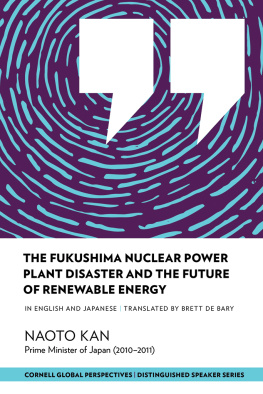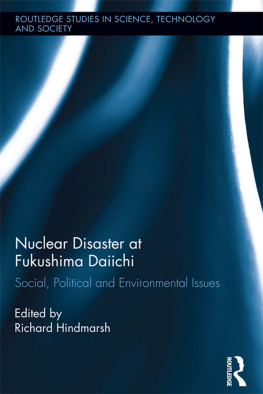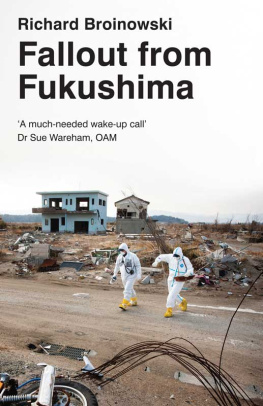Naoto Kan - My Nuclear Nightmare: Leading Japan Through the Fukushima Disaster to a Nuclear-Free Future
Here you can read online Naoto Kan - My Nuclear Nightmare: Leading Japan Through the Fukushima Disaster to a Nuclear-Free Future full text of the book (entire story) in english for free. Download pdf and epub, get meaning, cover and reviews about this ebook. City: Ithaca, year: 2017, publisher: Cornell University Press, genre: Politics. Description of the work, (preface) as well as reviews are available. Best literature library LitArk.com created for fans of good reading and offers a wide selection of genres:
Romance novel
Science fiction
Adventure
Detective
Science
History
Home and family
Prose
Art
Politics
Computer
Non-fiction
Religion
Business
Children
Humor
Choose a favorite category and find really read worthwhile books. Enjoy immersion in the world of imagination, feel the emotions of the characters or learn something new for yourself, make an fascinating discovery.

My Nuclear Nightmare: Leading Japan Through the Fukushima Disaster to a Nuclear-Free Future: summary, description and annotation
We offer to read an annotation, description, summary or preface (depends on what the author of the book "My Nuclear Nightmare: Leading Japan Through the Fukushima Disaster to a Nuclear-Free Future" wrote himself). If you haven't found the necessary information about the book — write in the comments, we will try to find it.
Naoto Kan, who was prime minister of Japan when the March 2011 Fukushima nuclear disaster began, has become a ubiquitous and compelling voice for the global antinuclear movement. Kan compared the potential worst-case devastation that could be caused by a nuclear power plant meltdown as tantamount only to a great world war. Nothing else has the same impact. Japan escaped such a dire fate during the Fukushima disaster, said Kan, only due to luck. Even so, Kan had to make some steely-nerved decisions that necessitated putting all emotion aside. In a now famous phone call from Tepco, when the company asked to pull all their personnel from the out-of-control Fukushima site for their own safety, Kan told them no. The workforce must stay. The few would need to make the sacrifice to save the many. Kan knew that abandoning the Fukushima Daiichi site would cause radiation levels in the surrounding environment to soar. His insistence that the Tepco workforce remain at Fukushima was perhaps one of the most unsung moments of heroism in the whole sorry saga.The Ecologist
On March 11, 2011, a massive undersea earthquake off Japans coast triggered devastating tsunami waves that in turn caused meltdowns at three reactors in the Fukushima Daiichi Nuclear Power Plant. Ranked with Chernobyl as the worst nuclear disaster in history, Fukushima will have lasting consequences for generations. Until 3.11, Japans Prime Minister, Naoto Kan, had supported the use of nuclear power. His position would undergo a radical change, however, as Kan watched the nuclear disaster at the Fukushima No. 1 Power Plant unfold and came to understand the potential for the physical, economic, and political destruction of Japan.
In My Nuclear Nightmare, Kan offers a fascinating day-by-day account of his actions in the harrowing week after the earthquake struck. He records the anguished decisions he had to make as the scale of destruction became clear and the threat of nuclear catastrophe loomed ever largerdecisions made on the basis of information that was often unreliable. For example, frustrated by the lack of clarity from the executives at Tepco, the company that owned the power plant, Kan decided to visit Fukushima himself, despite the risks, so he could talk to the plants manager and find out what was really happening on the ground. As he details, a combination of extremely good fortune and hard work just barely prevented a total meltdown of all of Fukushimas reactor units, which would have necessitated the evacuation of the thirty million residents of the greater Tokyo metropolitan area.
In the book, first published in Japan in 2012, Kan also explains his opposition to nuclear power: I came to understand that a nuclear accident carried with it a risk so large that it could lead to the collapse of a country. When Kan was pressured by the opposition to step down as prime minister in August 2011, he agreed to do so only after legislation had been passed to encourage investments in alternative energy. As both a document of crisis management during an almost unimaginable disaster and a cogent argument about the dangers of nuclear power, My Nuclear Nightmare is essential reading.
Naoto Kan: author's other books
Who wrote My Nuclear Nightmare: Leading Japan Through the Fukushima Disaster to a Nuclear-Free Future? Find out the surname, the name of the author of the book and a list of all author's works by series.








